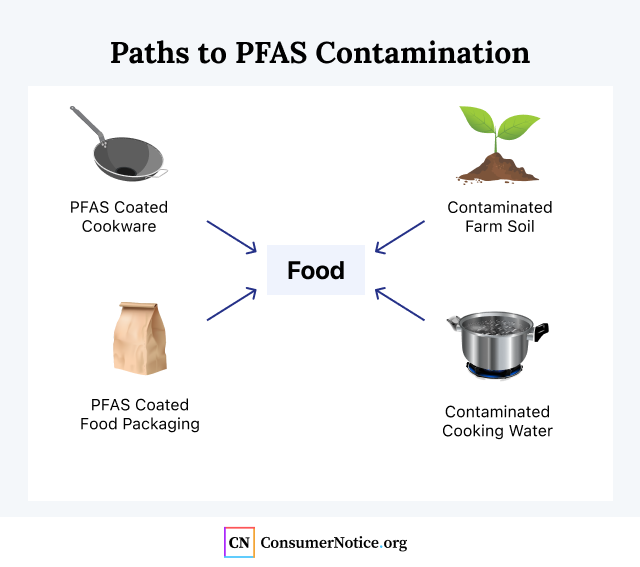PFAS in Food
Food and Drug Administration tests have found per- and polyfluoroalkyl substances in food and food packaging, including packaging from major national brands. Food can become contaminated from forever chemicals in soil and water. Seafood is the food most commonly found to have PFAS.

How Are People Exposed to PFAS in Their Diets?
Several common types of food, including meat, seafood, dairy, grains and produce can contain PFAS. Tests of several brands’ food packing have revealed elevated PFAS levels. Consuming contaminated foods exposes individuals to potentially dangerous levels of the chemicals.
Cooking with contaminated water can also be a significant source of exposure to PFAS in food. Both tap water and some bottled waters have been found to contain potentially dangerous levels of forever chemicals.
“If your water is above the current standards, NHDES recommends using an alternative source of water for cooking. Boiling water does not remove the regulated PFAS and may concentrate PFAS into some foods. Consuming foods that contain PFAS increases your overall exposure as ingestion is the primary way PFAS enter the body.”
Exposure through PFAS-containing food packaging and cooking tools is also a risk. For example, the non-stick coatings on pots, pans and some utensils can contaminate food.
Oil- or water-resistant coatings on food packaging also use these chemicals. This is common in paper or other fiber-based packing products, such as pizza boxes, soup cups or sandwich wrappers.
How Does Food Become Contaminated With PFAS?
Contaminated soil, ground and surface water, and animal feed are the most prevalent paths for PFAS to contaminate food. When farmers grow crops in contaminated soil or use PFAS-contaminated water for irrigation, the resulting grains and produce absorb the PFAS.
Industrial pollution is a key source of PFAS in soil and water. Waste from manufacturing plants gets into runoff and contaminates farmland and groundwater sources. This type of environmental pollution can persist for decades after removing its source.

Pollution from firefighting foam is also a source of PFAS contamination that can lead to soil and water pollution, risking contaminating food sources. Groundwater and soil around many military bases that use the foam in training exercises routinely show elevated PFAS levels.
PFAS take a long time to break down and therefore remain in the environment for many years. It is estimated that some PFAS compounds can take more than 1,000 years to degrade in soil and more than 40 years in water. As a result, levels accumulate over time.
What Foods Contain PFAS?
Seafood is a major source of dietary exposure to PFAS. Data is limited, but shellfish appear to contain the highest levels, with lean and fatty fish following at the top of the list. Other meats, dairy products, produce and grains have tested positive for PFAS as well.
“Seafood consumption has been identified as one of the major contributors of per- and poly(fluoroalkyl) substances (PFASs) to the human diet.”
Researchers have found PFAS in a wide range of foods. U.S. Food and Drug Administration testing shows these chemicals in many off-the-shelf items.
Testing of a store-bought cake mix revealed PFAS levels were more than 250 times federal advisories for PFAS levels in drinking water. FDA researchers suggested the significant levels were attributable to absorption of forever chemicals in coated packaging.
What Food Packaging Contains PFAS?
Testing revealed PFAS in food packaging from many popular retail grocery stores and restaurants. Fast food chains, including Arby’s, Burger King and Chick-fil-A, were major offenders. Several have since committed to eliminating PFAS from their food packaging.
Grocery stores, including several that claim to offer healthy and environmentally friendly alternatives, also relied heavily on PFAS-coated packaging. Soup cups are a persistent problem, as are bakery packaging and single-serve containers.
- Arby’s
- Burger King
- Chick-fil-A
- Kraft Heinz
- Kroger
- McDonald’s
- Nathan’s Famous
- Panera Bread
- Stop & Shop
- Tim Hortons
- Trader Joe’s
Microwave popcorn bags, takeout containers and other grease-resistant wrappers may all contain PFAS. Pet food bags have also been found to contain the chemicals.
As awareness of the health risks associated with PFAS grows, consumers are increasingly holding manufacturers responsible for their behavior. For example, Kraft Heinz is currently facing litigation over these toxic forever chemicals in its beverages.
Health Risks of PFAS in Food
Although research is still ongoing, the potentially serious health effects of high-level PFAS exposure are well documented. They include an increased risk of several types of cancer.
- Kidney cancer: Researchers have identified a potential link between increased rates of kidney cancer and exposure to high levels of PFAS.
- Liver cancer: Studies show that high concentrations of certain PFAS may contribute to the progression of liver cancer.
- Pancreatic cancer: Several animal studies show a possible association between elevated PFAS levels and increased risk for pancreatic cancer.
- Prostate cancer: Studies of highly exposed individuals show a potential association between PFAS exposure and prostate cancer. However, this connection is not evident in general population studies.
- Testicular cancer: Several studies document higher rates of testicular cancer in PFAS-contaminated areas compared to non-contaminated areas. Review of data shows a strong possibility PFAS contributes to testicular cancer.
- Ulcerative colitis: There is some evidence that increased PFAS levels may contribute to gastrointestinal disease, including ulcerative colitis. This is especially concerning because inflammatory bowel disease is a precursor for colorectal cancer.
Additionally, high-level PFAS exposure in food could contribute to increased blood cholesterol levels and reduced vaccine efficacy in children. Exposure could also increase risk of pre-eclampsia, a type of high blood pressure during pregnancy.
Are PFAS in Food Regulated?
Constituents have increased pressure on elected officials to enact legislation. Currently, most of the efforts occurring are at the state level. The Environmental Protection Agency and FDA have issued advisories about the safety of PFAS in food, drinking water and food packaging materials.
- California enacted legislation banning all PFAS from food packaging starting in 2022.
- Connecticut passed Public Act 21-191, which immediately banned the use of PFAS-containing firefighting foam and phases out the use of PFAS in food packaging.
- In October 2021, the EPA released a PFAS Strategic Roadmap detailing efforts to curb PFAS contamination.
Increasing legislation and oversight of PFAS in food can help increase food safety. Given that PFAS accumulate in the environment for years, communities remain at risk for many years after exposure.
Symptoms of related diseases may appear long after that initial exposure. As a result, there are several lawsuits over PFAS contamination playing out in the court system.
How Can I Protect Myself and My Family from PFAS in Food?
The best way to protect yourself and your family from PFAS in food is to choose products and brands that commit to not using these chemicals. Washing fresh foods, limiting seafood intake and using filtered water are also effective ways for avoiding PFAS in food.
- Avoid food with grease-resistant packaging, such as microwave popcorn and fast food wrappers
- Wash fruits and vegetables before cooking or eating them
- Test drinking water and research bottled water companies
- Shop for brands that use PFAS-free packaging
Food packaging and preparation tools may also contain PFAS. You can choose safe alternatives, such as stainless steel or cast iron pans instead of non-stick cookware to further limit exposure. Choosing brands that use packaging without PFAS further limits chemicals leaching into your food.
12 Cited Research Articles
Consumernotice.org adheres to the highest ethical standards for content production and references only credible sources of information, including government reports, interviews with experts, highly regarded nonprofit organizations, peer-reviewed journals, court records and academic organizations. You can learn more about our dedication to relevance, accuracy and transparency by reading our editorial policy.
- National Institute of Environmental Health Sciences. (2023, August 17). Perfluoroalkyl and Polyfluoroalkyl Substances (PFAS). Retrieved from: https://www.niehs.nih.gov/health/topics/agents/pfc/index.cfm
- Durham, J. (2023, August 15). The role of perfluorooctane sulfonic acid (PFOS) exposure in inflammation of intestinal tissues and intestinal carcinogenesis. Retrieved from: https://www.frontiersin.org/articles/10.3389/ftox.2023.1244457/full
- FDA. (2023, May 21). Authorized Uses of PFAS in Food Contact Applications. Retrieved from: https://www.fda.gov/food/process-contaminants-food/authorized-uses-pfas-food-contact-applications
- Rhee J. et al. (2023, March 22). A prospective nested case-control study of serum concentrations of per- and polyfluoroalkyl substances and aggressive prostate cancer risk. Retrieved from: https://www.sciencedirect.com/science/article/pii/S0013935123005108
- Rosenfeld P.E. et al. (2023, March 1). Perfluoroalkyl substances exposure in firefighters: Sources and implications. Retrieved from: https://www.sciencedirect.com/science/article/pii/S0013935122024914
- Del Firore, P. et al. (2022, December 9). Per- and polyfluoroalkyl substances (PFAS) exposure in melanoma patients: a retrospective study on prognosis and histological features. Retrieved from: https://ehjournal.biomedcentral.com/articles/10.1186/s12940-022-00944-x
- Law H.D. et al. (2022, December 9). Relative rates of cancers and deaths in Australian communities with PFAS environmental contamination associated with firefighting foams: A cohort study using linked data. Retrieved from: https://www.sciencedirect.com/science/article/pii/S1877782122002016
- Qi, Q. et al. (2022, October 17). Per- and polyfluoroalkyl substances activate UPR pathway, induce steatosis and fibrosis in liver cells. Retrieved from: https://onlinelibrary.wiley.com/doi/10.1002/tox.23680
- Young, W. et al. (2022, October 17). Analysis of Per- and Poly(fluoroalkyl) Substances (PFASs) in Highly Consumed Seafood Products from U.S. Markets. Retrieved from: https://pubs.acs.org/doi/10.1021/acs.jafc.2c04673
- Kamendulis, L. M. et al.. (2022, January 17). Exposure to perfluorooctanoic acid leads to promotion of pancreatic cancer. Retrieved from: https://academic.oup.com/carcin/article/43/5/469/6504004
- Steenlanda K. & Winquist A. (2021, March). PFAS and cancer, a scoping review of the epidemiologic evidence. Retrieved from: https://www.sciencedirect.com/science/article/pii/S0013935120315899
- Roth, K. et al. (2020, December 4). Diet as an Exposure Source and Mediator of Per- and Polyfluoroalkyl Substance (PFAS). Retrieved from: https://www.frontiersin.org/articles/10.3389/ftox.2020.601149/full
Calling this number connects you with a Consumer Notice, LLC representative. We will direct you to one of our trusted legal partners for a free case review.
Consumer Notice, LLC's trusted legal partners support the organization's mission to keep people safe from dangerous drugs and medical devices. For more information, visit our partners page.
855-493-2793
